
Mount Vesuvius is a somma–stratovolcano located on the Gulf of Naples in Campania, Italy, about 9 km (5.6 mi) east of Naples and a short distance from the shore. It is one of several volcanoes forming the Campanian volcanic arc. Vesuvius consists of a large cone partially encircled by the steep rim of a summit caldera, resulting from the collapse of an earlier, much higher structure.

A stratovolcano, also known as a composite volcano, is a typically conical volcano built up by many alternating layers (strata) of hardened lava and tephra. Unlike shield volcanoes, stratovolcanoes are characterized by a steep profile with a summit crater and explosive eruptions. Some have collapsed summit craters called calderas. The lava flowing from stratovolcanoes typically cools and solidifies before spreading far, due to high viscosity. The magma forming this lava is often felsic, having high to intermediate levels of silica, with lesser amounts of less viscous mafic magma. Extensive felsic lava flows are uncommon, but can travel as far as 8 km (5 mi).

Mount Etna, or simply Etna, is an active stratovolcano on the east coast of Sicily, Italy, in the Metropolitan City of Catania, between the cities of Messina and Catania. It is located above the convergent plate margin between the African Plate and the Eurasian Plate. It is one of the tallest active volcanoes in Europe, and the tallest peak in Italy south of the Alps with a current height of 3,403 m (11,165 ft), though this varies with summit eruptions. For instance, in 2021 the southeastern crater reached a height of 3,357 m, but was then surpassed by the Voragine crater after the summer 2024 eruptions.

Torre del Greco is a comune in the Metropolitan City of Naples in Italy, with a population of c. 85,000 as of 2016. The locals are sometimes called Corallini because of the once plentiful coral in the nearby sea, and because the city has been a major producer of coral jewellery and cameo brooches since the seventeenth century.

The volcanism of Italy is due chiefly to the presence, a short distance to the south, of the boundary between the Eurasian Plate and the African Plate. Italy is a volcanically active country, containing the only active volcanoes in mainland Europe. The lava erupted by Italy's volcanoes is thought to result from the subduction and melting of one plate below another.

San Sebastiano al Vesuvio is a comune (municipality) in the Metropolitan City of Naples, located on the western slopes of Mount Vesuvius. Its elevation means that it is often a few degrees cooler than the neighbouring metropolis of Naples.

The Phlegraean Fields is a large caldera volcano west of Naples, Italy. It is part of the Campanian volcanic arc, which includes Mount Vesuvius, about 9 km east of Naples. The Phlegraean Fields is monitored by the Vesuvius Observatory. It was declared a regional park in 2003.
The Decade Volcanoes are 16 volcanoes identified by the International Association of Volcanology and Chemistry of the Earth's Interior (IAVCEI) as being worthy of particular study in light of their history of large, destructive eruptions and proximity to densely populated areas. The Decade Volcanoes project encourages studies and public-awareness activities at these volcanoes, with the aim of achieving a better understanding of the volcanoes and the dangers they present, and thus being able to reduce the severity of natural disasters.
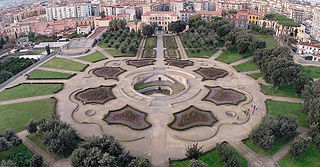
San Giorgio a Cremano is a primarily residential town and comune in the Metropolitan City of Naples, in Italy. It is located on the foothills of Mount Vesuvius to the west of the volcano and the sea, and is five kilometres to the south east of the centre of Naples. Most parts of the municipality command views of Mount Vesuvius, Mount Somma and the Bay of Naples.
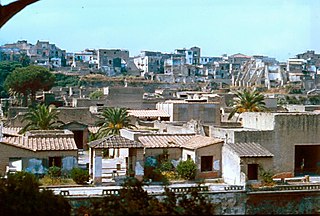
Ercolano is a town and comune in the Metropolitan City of Naples, Campania of Southern Italy. It lies at the western foot of Mount Vesuvius, on the Bay of Naples, just southeast of the city of Naples. The medieval town of Resina was built on the volcanic material left by the eruption of Vesuvius that destroyed the ancient city of Herculaneum, from which the present name is derived. Ercolano is a resort and the starting point for excursions to the excavations of Herculaneum and for the ascent of Vesuvius by bus. The town also manufactures leather goods, buttons, glass, and Lacryma Christi wine.

Boscoreale is an Italian comune (municipality) and town in the Metropolitan City of Naples, Campania, with a population of 25,939 in 2022. Located in the Vesuvius National Park, under the slopes of Mount Vesuvius, it is known for the fruit and vineyards of Lacryma Christi del Vesuvio. There is also a fine Vesuvian lava stone production.
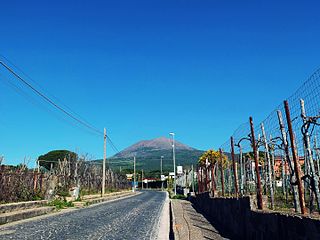
Boscotrecase is a town and municipality of 9,790 inhabitants in the metropolitan city of Naples in Campania, Italy.

Ottaviano is a comune (municipality) in the Metropolitan City of Naples in the Italian region of Campania, located about 20 kilometres (12 mi) east of Naples and is located in the Vesuvian Area. Ottaviano was in Roman times a hamlet of houses within a vast estate belonging to the gens Octavia, Augustus' family.

Palma Campania, known until 1863 as Palma di Nola, is a comune (municipality) in the Metropolitan City of Naples in the Italian region Campania, located about 25 km east of Naples.
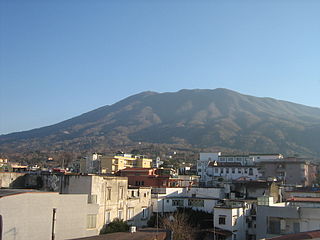
Sant'Anastasia is a comune (municipality) in the Metropolitan City of Naples in the Italian region Campania, located about 13 kilometres northeast of Naples.
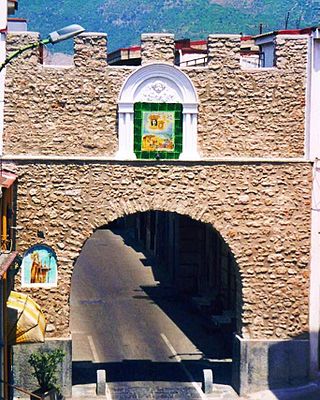
Striano is an Italian municipality of 8,764 inhabitants in the Metropolitan City of Naples in Campania, located in the Sarno Valley.
Terzigno is a comune (municipality) in the Metropolitan City of Naples in the Italian region Campania, located about 20 km east of Naples. As of 31 December 2004, it had a population of 16,977 and an area of 23.5 km2.
Running beneath the Italian city of Naples and the surrounding area is an underground geothermal zone and several tunnels dug during the ages. This geothermal area is present generally from Mount Vesuvius beneath a wide area including Pompei, Herculaneum, and from the volcanic area of Campi Flegrei beneath Naples and over to Pozzuoli and the coastal Baia area. Mining and various infrastructure projects during several millennia have formed extensive caves and underground structures in the zone.

Lava is molten or partially molten rock (magma) that has been expelled from the interior of a terrestrial planet or a moon onto its surface. Lava may be erupted at a volcano or through a fracture in the crust, on land or underwater, usually at temperatures from 800 to 1,200 °C. The volcanic rock resulting from subsequent cooling is also often called lava.

Of the many eruptions of Mount Vesuvius, a major stratovolcano in Southern Italy, its eruption in 1631 is the most destructive episode in the recent history and one of the deadliest of all time.






















